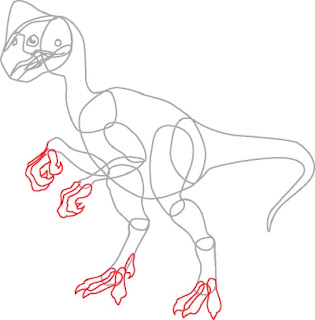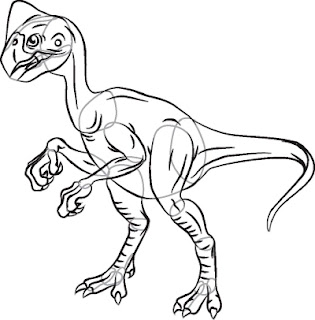The Oviraptor dinosaur's most intimidating feature are its sharp, large claws. Pay close attention to details when drawing this dinosaur.
In this section, we'll show you how to draw this Oviraptor dinosaur. You can draw it freehand while looking at your computer monitor, or you can print out this page to get a closer look at each step.
Here, we'll show you an illustration of each step and then give you a description of how to draw it. Follow the red lines in each illustration to learn exactly what to draw in that step. The lines drawn in previous steps are shown in gray.
Are you ready to get started? Check out the next page for the first step.
In this section, we'll show you how to draw this Oviraptor dinosaur. You can draw it freehand while looking at your computer monitor, or you can print out this page to get a closer look at each step.
Here, we'll show you an illustration of each step and then give you a description of how to draw it. Follow the red lines in each illustration to learn exactly what to draw in that step. The lines drawn in previous steps are shown in gray.
Are you ready to get started? Check out the next page for the first step.
 1. Draw the Head and Body
1. Draw the Head and BodyStart with two potato shapes -- a large one for the body and a smaller one for the head. Connect the two shapes with another curved shape to form the neck.
We'll add the tail in the next step.
 2. Draw the Tail
2. Draw the TailDraw two curved lines that meet in a point to make the tail. Split the head into two shapes, one thick and one thin, for the upper and lower jaws. Add a rounded triangle on top of the head for the crest.
Head over to the next page to learn how to draw the legs.
 3. Add the Legs
3. Add the LegsDraw a long oval, slightly bent at the bottom, for the thigh on the near side of the body. Overlap a smaller peanut shape at the end to form the shin, and draw another long, rounded rectangle for the foot. The thigh on the far side of the Oviraptor is hidden, so draw a slightly curved oval for the shin and another long, rounded rectangle for the foot.
You'll learn how to draw the arms and beak on the next page.
 4. Add the Beak and Arms
4. Add the Beak and ArmsDraw a kidney-bean shape for the upper arm on the near side, and add a bowling-pin shape for the forearm. The upper arm on the far side is hidden, so draw another bowling-pin shape for the forearm on the far side. Add a circle for the eye and a crescent inside the circle for the eyeball. Draw another circle for the ear and a teardrop for the nostril. The Oviraptor has a beak, so draw a shape that's almost like a mitten just above the mouth. Draw a teardrop shape in the mouth to make the tongue, and add details to the rest of the mouth.
Our dinosaur doesn't look mean enough. Let's add the claws. Head over to the next page to find out how.
 5. Add the Claws
5. Add the ClawsMake a hook at the end of each arm for a finger and claw. At the side of each finger, draw two more lines that each follow the same shape. These are the back fingers, which are mostly hidden from view. On the hand at the far side, don't forget to add one more smaller hook shape for the thumb. Add three longer spike shapes at the end of each foot for more claws. Be sure to include a fourth claw on the back of the far foot.
Check out the next page to learn how to add muscle and skin details.
 6. Add Muscle and Skin Details
6. Add Muscle and Skin DetailsDraw in lines to add detail. The lines on the tail, legs, and arms show muscles, while the lines over the rest of the body show skin folds.
We're almost done! Check out the next page to learn how to add the final touches.
 7. Add the Final Touches
7. Add the Final TouchesDraw over the pencil lines you want to keep with a felt-tip pen. Erase the extra pencil lines, and the dinosaur is ready for you to color.
 Your dinosaur is finished! Even if you don't get it right the first time, keep practicing until you're happy with your drawing.
Your dinosaur is finished! Even if you don't get it right the first time, keep practicing until you're happy with your drawing. The Diplodocus dinosaur's tail is longer than the length of its body. Learn how to draw this dinosaur -- in just five steps.
No comments:
Post a Comment